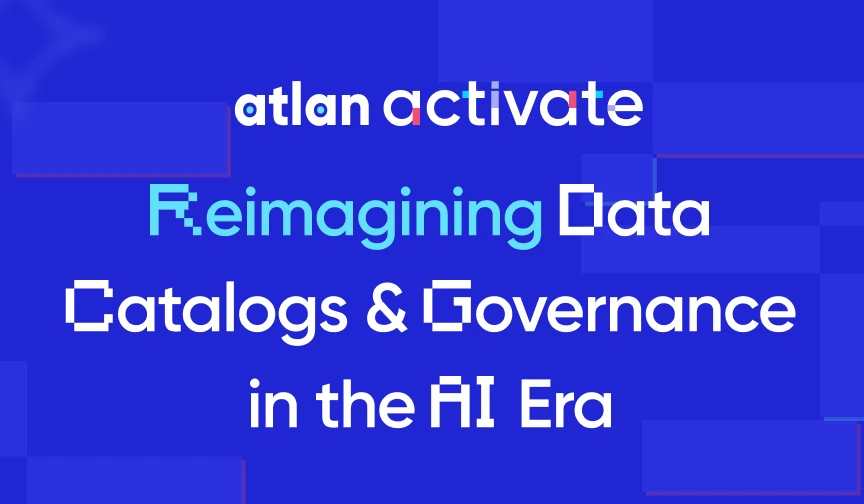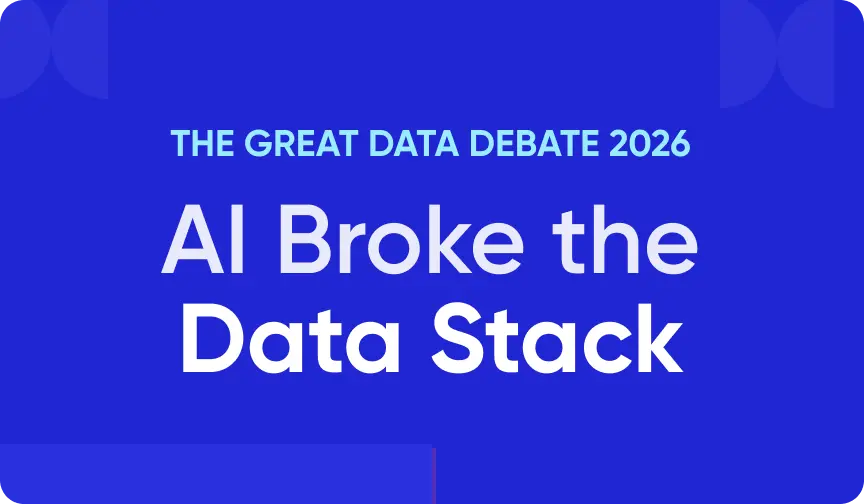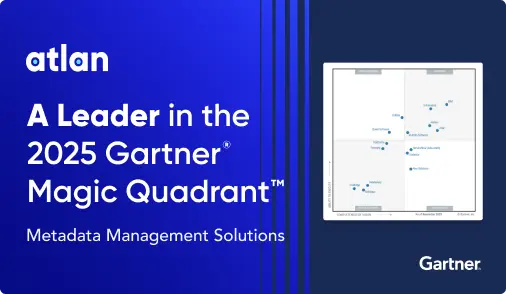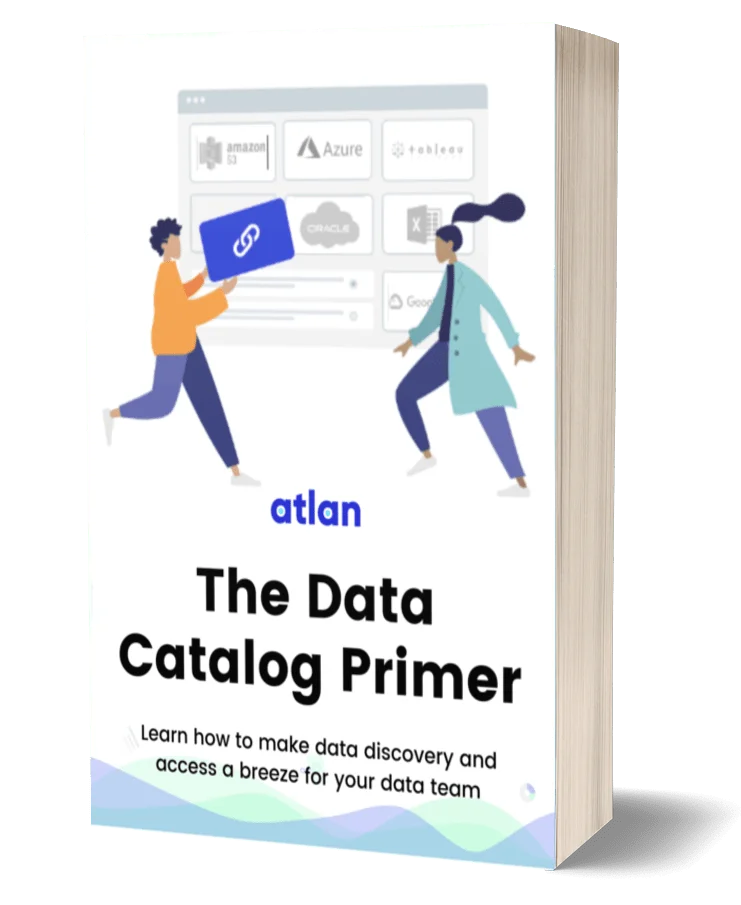Data Catalog Vs. Metadata Management: Differences, and How They Work Together?
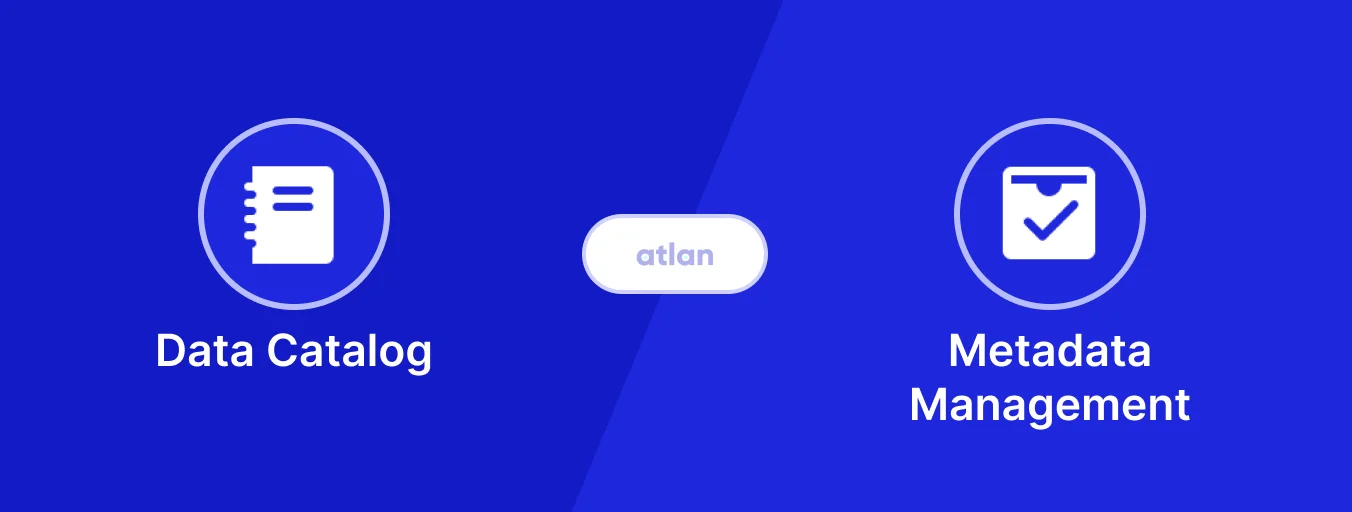
Share this article
Data catalog vs. metadata management: Key differences
Permalink to “Data catalog vs. metadata management: Key differences”The main difference between metadata management and a data catalog is that metadata management is a strategy or approach to handling your data. In contrast, a data catalog is a tool — a means to support metadata management.
See How Atlan Simplifies Data Cataloging – Start Product Tour ➜
Here’s a table summarizing the difference between data catalog and metadata management.
| Aspect | Data Catalog | Metadata Management |
|---|---|---|
| Definition | A data catalog is an organized list of all the data assets which empower data teams throughout the company. | Metadata management helps organizations decide how to collect, analyze, and maintain contextual information — metadata. |
| Scope | It serves as an organized data inventory for all data sources. It enables data search and discovery of data assets, with the right context. | It ensures that the metadata is used as per the data governance policies. |
| Key difference | It is a tool that enables metadata management, among other things such as data discovery, profiling, quality, and governance. | It is an approach to manage the collection, storage, and use of metadata. |
Table of Contents
Permalink to “Table of Contents”- Data catalog vs. metadata management: Key differences
- What is a data catalog?
- What is metadata management?
- Metadata vs. master data vs. reference data
- Does a data catalog include metadata?
- Enable efficient metadata management with a robust data catalog
- How organizations making the most out of their data using Atlan
- FAQs about Data Catalog vs Metadata Management
- Data catalog vs. Metadata management: Related reads
Data catalog vs. metadata management — is there a difference? These concepts are often used interchangeably in the data ecosystem.
While there are several differences between the two terminologies, here’s a brief explanation — data catalogs are tools that enable metadata management. So, rather than an either-or debate, explore ways to set up a catalog that supports effective metadata management.
Instead of data catalog vs. metadata management, think data cataloging + metadata management for better data management.
This article analyzes the concepts of cataloging and metadata management, and their synergies and differences.
First, let’s start with data cataloging.
What is a data catalog?
Permalink to “What is a data catalog?”A data catalog is a tool that helps set up a comprehensive list of an organization’s data assets. The data catalog makes it easier for data engineers and business analysts to find and use the right data.
A centralized data catalog can effectively break down data silos to enable better data accessibility throughout an organization.
Moreover, data catalogs built for the modern data stack can trace lineage and help set up granular access policies and permissions. This enables better data security and compliance with various data protection regulations and privacy laws.
Interested in learning more about data catalogs? Check out our in-depth guide exploring the value, benefits, and features of data catalogs.
Another thing to note before we move on to metadata — data catalogs differ from data dictionaries. Here’s why.
Data catalog vs. data dictionary
Permalink to “Data catalog vs. data dictionary”As we’ve already mentioned, data cataloging is the process of organizing or inventorying data assets.
A modern data catalog can include a metadata repository, a business glossary for context, a Google-like search to enable data discoverability, and capabilities to ensure good governance. The scope varies depending on the needs of an organization.
Meanwhile, a data dictionary describes data types and data structures included in a database, data model, or data source.
The IT team use to maintain an organization’s data dictionary to handle metadata management in the past. However, with more data consumers and business users, a data dictionary has become one of the building blocks of a more comprehensive data catalog.
To know more about a data dictionary and its benefits, here’s an article that you might find helpful.
The biggest advantage of integrating a data dictionary, business glossary, and search and discovery capabilities within data catalogs is data democratization.
Learn more: Data catalog vs. Data dictionary — differences, examples, and use cases
The role of data catalog in data democratization
Permalink to “The role of data catalog in data democratization”According to Bernard Marr, the bestselling author of “Big Data in Practice”:
"Data democratization implies that data is accessible to everyone or that there are no gatekeepers that create a bottleneck at the gateway or entry point to the data.”
Data democratization empowers everyone within an organization to access the data they want when they want it. So, everyone can quickly find, understand, and use the right data for strategic decision-making.
A robust data catalog platform enables data democratization without compromising data security or privacy by empowering data teams with various features, such as:
- Data search and discovery
- Business glossary and data dictionary
- Automated data profiling and auto-glossary suggestions
- API integrations with the rest of the modern data stack
- In-line chat, annotations, and one-click data sharing for seamless collaboration
- Data lineage and impact analysis
Now let’s look at metadata management.
What is metadata and what is metadata management?
Permalink to “What is metadata and what is metadata management?”Metadata is data that describes data.
For example, the metadata of an image includes the image name, description, format, size, author, date created, and date modified.
Similarly, an excel sheet containing employee records has extensive metadata information. The metadata for each column of the excel sheet includes a name, description, data type, and more.
In a modern data stack, business stakeholders often confuse metadata and use it interchangeably with master data and reference data. So let’s understand these concepts.
Metadata vs. master data vs. reference data
Permalink to “Metadata vs. master data vs. reference data”The main difference between Metadata, Master data, and reference data is that metadata is descriptive information about data that aids an organization in making sense of its data. Master data is essential business information that you need for transactions. Examples include descriptions of customers, products, parts from suppliers, and other such information from transactional data. Finally, reference data is a subset of master data. It’s the data referred to by various systems within an organization’s business processes.
Metadata is descriptive information about data that aids an organization in making sense of its data.
For example, the metadata for a customer record database would include information such as column names, column data types, and descriptions, format.
To know more about metadata, check out our detailed guide on metadata and using it to unlock the value of your data assets.
Next up is master data.
Master data is essential business information that you need for transactions. Examples include descriptions of customers, products, parts from suppliers, and other such information from transactional data.
Gartner defines master data as:
Master data is the consistent and uniform set of identifiers and extended attributes that describes the core entities of the enterprise including customers, prospects, citizens, suppliers, sites, hierarchies and chart of accounts.
You need meta data to manage master data. That’s why master data management and metadata are like two sides of the same coin, according to Forrester:
MDM usually involves some business-focused statement about achieving a single trusted view of a customer, product, or some other critical data, while IT typically looks at metadata to reduce complexity, and increase productivity, reuse, and collaboration, by having a single version of truth about their company’s “data about data.”
Finally, reference data is a subset of master data. It’s the data referred to by various systems within an organization’s business processes.
Some of the reference data is standardized as per the specifications from governing bodies like ISO. Examples include country codes, postal codes, and currency codes.
Others, like customer status or product categories, are defined within an organization.
Coming back to metadata, effectively managing all that information builds a complete picture of the data and makes it more understandable and meaningful.
Metadata management is a set of policies and processes that govern the storage and use of metadata.
If done right, metadata management helps organizations comply with data laws while empowering data democratization within an organization.
Traditionally, you could handle metadata management with excel sheets and structured databases. However, with the rise of big data and cloud computing, metadata management has become challenging.
That’s where a data catalog can help.
Does a data catalog include metadata?
Permalink to “Does a data catalog include metadata?”As mentioned earlier, data catalogs are tools that consolidate metadata into a single repository, providing a complete picture of all data assets within an organization. So yes, they include metadata.
Modern data catalogs enable metadata management by offering an overview of all metadata from a single repository, thereby setting up a single source of truth for metadata.
Let’s see how.
Data catalog vs. metadata management: Where do data catalogs fit into metadata management?
Permalink to “Data catalog vs. metadata management: Where do data catalogs fit into metadata management?”Firstly, metadata management is a strategy or approach to handling your data. In contrast, a data catalog is a tool — a means to support metadata management.
Next, choosing a metadata management tool would only handle metadata, which may or may not provide adequate context and make discovery easier.
However, organizations can manage large swathes of data with data catalogs in a centralized, collaborative, and user-friendly manner with capabilities such as:
- Indexing the metadata
- Enabling search and discovery
- Simplifying governance
Here’s a table summarizing the difference between data catalog and metadata management.
| Aspect | Data Catalog | Metadata Management |
|---|---|---|
| Definition | A data catalog is an organized list of all the data assets which empower data teams throughout the company. | Metadata management helps organizations decide how to collect, analyze, and maintain contextual information — metadata. |
| Scope | It serves as an organized data inventory for all data sources. It enables data search and discovery of data assets, with the right context. | It ensures that the metadata is used as per the data governance policies. |
| Key difference | It is a tool that enables metadata management, among other things such as data discovery, profiling, quality, and governance. | It is an approach to manage the collection, storage, and use of metadata. |
Enable efficient metadata management with a robust data catalog
Permalink to “Enable efficient metadata management with a robust data catalog”A robust data catalog facilitates metadata management, among other things, to help organizations manage and use their data effectively. That’s why the debate shouldn’t be data catalog vs. metadata management, but data catalog + metadata management.
If you’re wondering what “robust” looks like, consider taking Atlan’s modern data catalog for a test drive.
A Demo of Atlan Enterprise Metadata Management Tool
How organizations making the most out of their data using Atlan
Permalink to “How organizations making the most out of their data using Atlan”The recently published Forrester Wave report compared all the major enterprise data catalogs and positioned Atlan as the market leader ahead of all others. The comparison was based on 24 different aspects of cataloging, broadly across the following three criteria:
- Automatic cataloging of the entire technology, data, and AI ecosystem
- Enabling the data ecosystem AI and automation first
- Prioritizing data democratization and self-service
These criteria made Atlan the ideal choice for a major audio content platform, where the data ecosystem was centered around Snowflake. The platform sought a “one-stop shop for governance and discovery,” and Atlan played a crucial role in ensuring their data was “understandable, reliable, high-quality, and discoverable.”
For another organization, Aliaxis, which also uses Snowflake as their core data platform, Atlan served as “a bridge” between various tools and technologies across the data ecosystem. With its organization-wide business glossary, Atlan became the go-to platform for finding, accessing, and using data. It also significantly reduced the time spent by data engineers and analysts on pipeline debugging and troubleshooting.
A key goal of Atlan is to help organizations maximize the use of their data for AI use cases. As generative AI capabilities have advanced in recent years, organizations can now do more with both structured and unstructured data—provided it is discoverable and trustworthy, or in other words, AI-ready.
Tide’s Story of GDPR Compliance: Embedding Privacy into Automated Processes
Permalink to “Tide’s Story of GDPR Compliance: Embedding Privacy into Automated Processes”- Tide, a UK-based digital bank with nearly 500,000 small business customers, sought to improve their compliance with GDPR’s Right to Erasure, commonly known as the “Right to be forgotten”.
- After adopting Atlan as their metadata platform, Tide’s data and legal teams collaborated to define personally identifiable information in order to propagate those definitions and tags across their data estate.
- Tide used Atlan Playbooks (rule-based bulk automations) to automatically identify, tag, and secure personal data, turning a 50-day manual process into mere hours of work.
Book your personalized demo today to find out how Atlan can help your organization in establishing and scaling data governance programs.
FAQs about Data Catalog vs Metadata Management
Permalink to “FAQs about Data Catalog vs Metadata Management”1. What is the difference between a data catalog and metadata management?
Permalink to “1. What is the difference between a data catalog and metadata management?”A data catalog is a tool that organizes and lists all data assets within an organization, facilitating data discovery. In contrast, metadata management is a strategy that governs how metadata is collected, analyzed, and maintained.
2. How do data catalogs enhance data discovery and accessibility?
Permalink to “2. How do data catalogs enhance data discovery and accessibility?”Data catalogs provide a centralized inventory of data assets, allowing users to search and discover relevant data easily. They often include features like search functionality, data lineage, and context to improve data accessibility.
3. What role does metadata management play in data governance?
Permalink to “3. What role does metadata management play in data governance?”Metadata management ensures that metadata is accurately collected, maintained, and used according to data governance policies. It helps organizations comply with regulations and maintain data quality by providing context and structure to data assets.
4. What are the best practices for implementing a data catalog in an organization?
Permalink to “4. What are the best practices for implementing a data catalog in an organization?”Best practices include defining clear objectives, involving stakeholders, ensuring data quality, and providing training for users. Regular updates and maintenance of the catalog are also essential for its effectiveness.
5. How can organizations ensure that their metadata remains up-to-date and relevant?
Permalink to “5. How can organizations ensure that their metadata remains up-to-date and relevant?”Organizations can implement automated processes for metadata updates, conduct regular audits, and establish clear governance policies. Engaging users in maintaining metadata accuracy is also crucial.
6. What challenges might arise when implementing a data catalog or metadata management system?
Permalink to “6. What challenges might arise when implementing a data catalog or metadata management system?”Challenges include data silos, resistance to change from users, ensuring data quality, and integrating with existing systems. Addressing these challenges requires careful planning and stakeholder engagement.
Data catalog vs. Metadata management: Related reads
Permalink to “Data catalog vs. Metadata management: Related reads”- Data Catalog: What It Is & How It Drives Business Value
- What Is a Metadata Catalog? - Basics & Use Cases
- Modern Data Catalog: What They Are, How They’ve Changed, Where They’re Going
- Open Source Data Catalog - List of 6 Popular Tools to Consider in 2026
- 5 Main Benefits of Data Catalog & Why Do You Need It?
- Enterprise Data Catalogs: Attributes, Capabilities, Use Cases & Business Value
- The Top 11 Data Catalog Use Cases with Examples
- 15 Essential Features of Data Catalogs To Look For in 2026
- Data Catalog vs. Data Warehouse: Differences, and How They Work Together?
- Snowflake Data Catalog: Importance, Benefits, Native Capabilities & Evaluation Guide
- Data Catalog vs. Data Lineage: Differences, Use Cases, and Evolution of Available Solutions
- Data Catalogs in 2026: Features, Business Value, Use Cases
- AI Data Catalog: Exploring the Possibilities That Artificial Intelligence Brings to Your Metadata Applications & Data Interactions
- Amundsen Data Catalog: Understanding Architecture, Features, Ways to Install & More
- Machine Learning Data Catalog: Evolution, Benefits, Business Impacts and Use Cases in 2026
- 7 Data Catalog Capabilities That Can Unlock Business Value for Modern Enterprises
- Data Catalog Architecture: Insights into Key Components, Integrations, and Open Source Examples
- Data Catalog Market: Current State and Top Trends in 2026
- Build vs. Buy Data Catalog: What Should Factor Into Your Decision Making?
- How to Set Up a Data Catalog for Snowflake? (2026 Guide)
- Data Catalog Pricing: Understanding What You’re Paying For
- Data Catalog Comparison: 6 Fundamental Factors to Consider
- Alation Data Catalog: Is it Right for Your Modern Business Needs?
- Collibra Data Catalog: Is It a Viable Option for Businesses Navigating the Evolving Data Landscape?
- Informatica Data Catalog Pricing: Estimate the Total Cost of Ownership
- Informatica Data Catalog Alternatives? 6 Reasons Why Top Data Teams Prefer Atlan
- Data Catalog Implementation Plan: 10 Steps to Follow, Common Roadblocks & Solutions
- Data Catalog Demo 101: What to Expect, Questions to Ask, and More
- Data Mesh Catalog: Manage Federated Domains, Curate Data Products, and Unlock Your Data Mesh
- Best Data Catalog: How to Find a Tool That Grows With Your Business
- How to Build a Data Catalog: An 8-Step Guide to Get You Started
- The Forrester Wave™: Enterprise Data Catalogs, Q3 2024 | Available Now
- How to Pick the Best Enterprise Data Catalog? Experts Recommend These 11 Key Criteria for Your Evaluation Checklist
- Collibra Pricing: Will It Deliver a Return on Investment?
- Data Lineage Tools: Critical Features, Use Cases & Innovations
- OpenMetadata vs. DataHub: Compare Architecture, Capabilities, Integrations & More
- Automated Data Catalog: What Is It and How Does It Simplify Metadata Management, Data Lineage, Governance, and More
- Data Mesh Setup and Implementation - An Ultimate Guide
- What is Active Metadata? Your 101 Guide
Photo by Trnava University on Unsplash
Share this article

